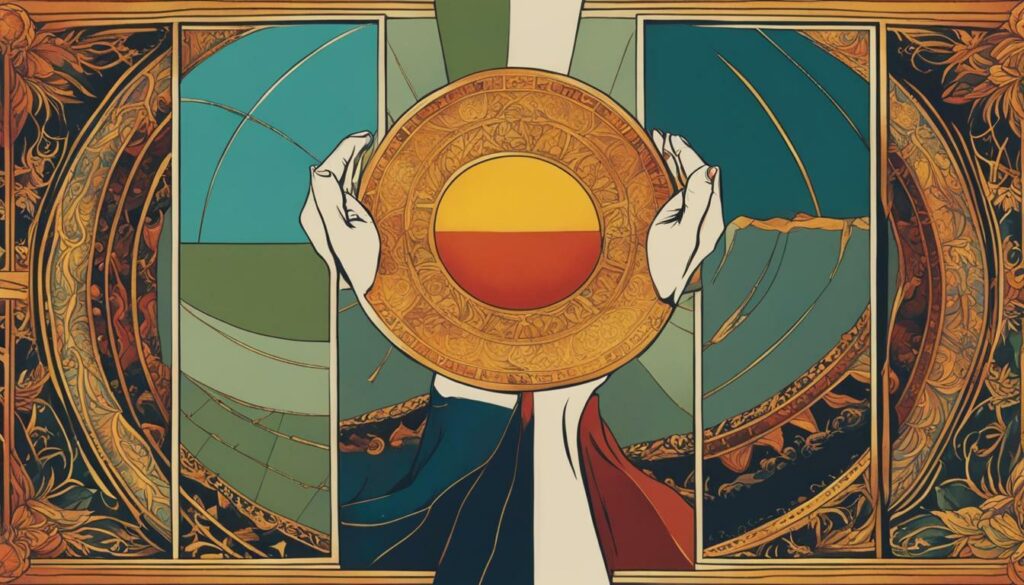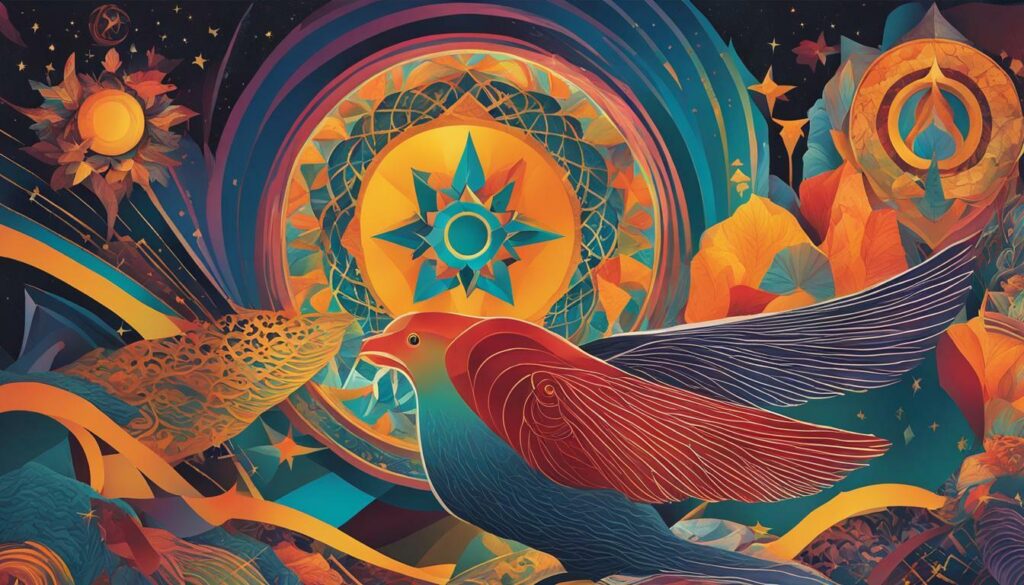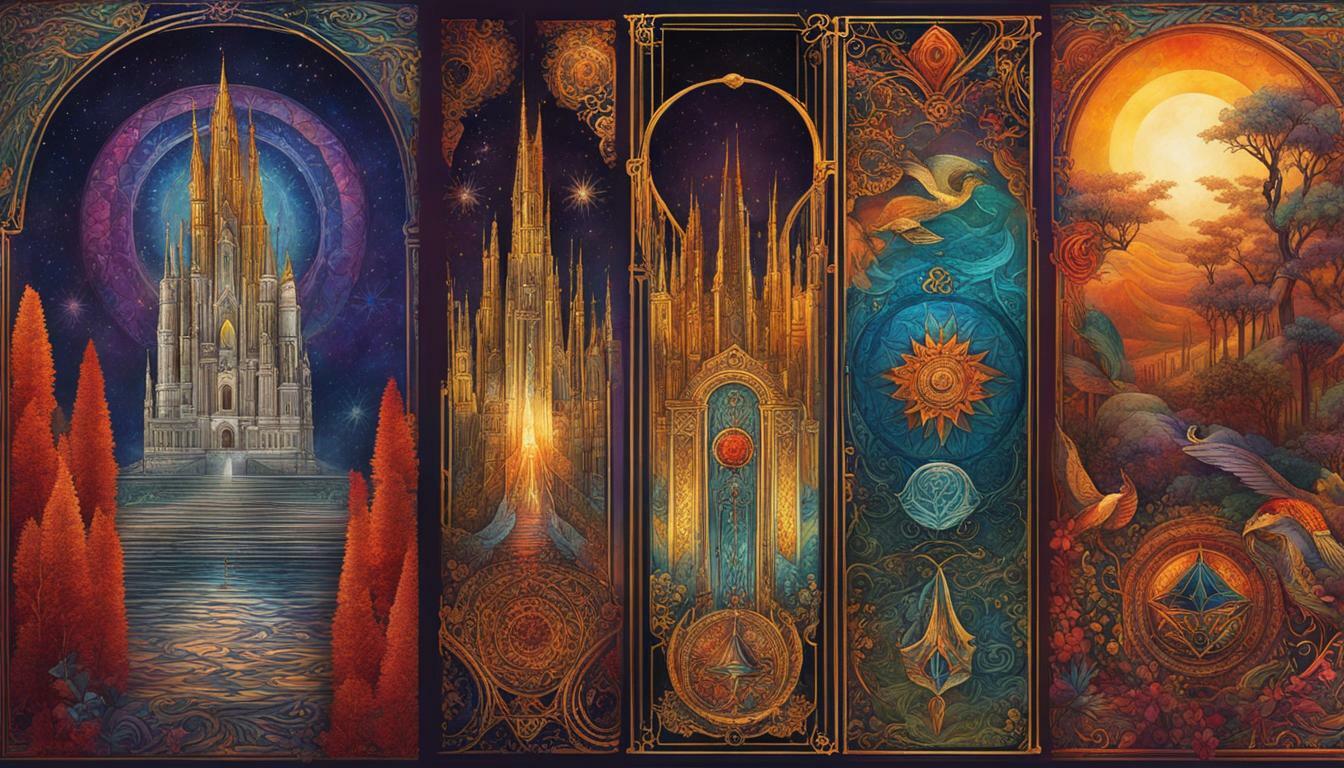Colors play a vital role in tarot readings, as they can evoke specific emotions, energies, and themes. But is there a consistent and universal meaning for each color in tarot, or does the interpretation depend on the specific context and the reader’s intuition?
In this section, we will explore the significance of color symbolism in tarot and how it can influence the interpretation of tarot cards. We will discuss whether there is a universal interpretation of colors, or if it varies based on the individual reader and the context.
Key Takeaways
- Colors play a crucial role in tarot readings.
- The interpretation of color symbolism in tarot can vary based on context and intuition.
- Understanding the significance of colors in tarot can enhance the accuracy of readings.
Understanding the significance of colors in tarot readings
Colors play a crucial role in tarot readings, influencing the interpretation of the cards and providing deeper insight into the themes and energies they represent. Each color has its own significance and symbolism, which can vary depending on the context and the individual reader’s intuition.
In traditional tarot symbolism, red represents passion, anger, or intense emotions, while blue is associated with calmness, communication, and spirituality. Green often represents growth, abundance, and the natural world, while yellow is associated with intellect, confidence, and creativity. Black is often depicted as representing mystery, death, or dark energies, while white symbolizes purity, clarity, and new beginnings.
Understanding the significance of color in tarot readings requires a nuanced approach that considers both universal symbolism and personal intuition. While there may be some consensus on the meanings of certain colors, it’s essential to consider the context of each reading and the individual’s personal associations with each color.
When interpreting the colors in tarot readings, it’s also essential to consider the overall energy of the spread and how the colors interact with each other. For example, a spread dominated by red and black may suggest intense emotions and potential danger, while a spread with a lot of green and blue may suggest growth, healing, and emotional balance.
Ultimately, the significance of colors in tarot readings goes beyond simple symbolism and requires a deep understanding of the cards, their context, and the individual’s intuitive insights. By paying close attention to the colors and their meanings, tarot readers can unlock new layers of insight and understanding in their readings.

In the next section, we will explore how specific colors relate to different categories of tarot cards and how they can enhance or modify their meanings.
The Role of Colors in Tarot Card Meanings
Colors play a crucial role in determining the meanings of tarot cards. Each color carries its unique energy and symbolism, which can significantly impact the interpretation of a tarot reading. Understanding the importance of color in tarot card meanings is essential for any serious tarot reader.
When exploring color meanings in tarot, it’s helpful to look at specific card categories, such as the Major Arcana and the Minor Arcana. Typically, the Major Arcana cards are associated with more profound, archetypical meanings, while the Minor Arcana represents more everyday situations and experiences.
| Color | Major Arcana | Minor Arcana |
|---|---|---|
| Red | Passion, action, power | Energy, ambition, desire |
| Blue | Spirituality, intuition, tranquility | Communication, expression, creativity |
| Green | Growth, prosperity, abundance | Healing, balance, harmony |
| Yellow | Confidence, optimism, enlightenment | Intellect, logic, mental clarity |
| Purple | Spiritual awakening, enlightenment, intuition | Royalty, luxury, indulgence |
| Orange | Creativity, vitality, excitement | Socializing, friendship, pleasure |
| Black | Mystery, transformation, endings | Protection, boundaries, fear |
| White | Purity, clarity, new beginnings | Innocence, clarity, simplicity |
These meanings are not set in stone and can vary depending on the reader’s intuition and the context of the reading. For example, a red card could represent anger and aggression in one reading, while in another, it might symbolize passion and desire.
It’s also essential to consider the color combinations within a tarot spread or individual card. The juxtaposition of colors can enhance or modify their meanings, adding layers of complexity to the reading.

In conclusion, exploring the role of colors in tarot card meanings is a nuanced and complex process. While there are traditional interpretations associated with each color, personal intuition and cultural influences can also significantly impact their meanings. Tarot readers should pay close attention to the energy and symbolism of different colors and consider them within the context of the reading.
Decoding color symbolism in tarot
Colors play a significant role in interpreting tarot cards. Every color has unique symbolism that can evoke various emotions and energies during a reading. Decoding the symbolism behind each color is essential to interpreting the true meaning of tarot cards.
Red: One of the most intense colors in tarot, red symbolizes passion, anger, and primal energy. In the Minor Arcana, the suit of Wands often features the color red, representing inspiration and motivation. In contrast, a card in the Major Arcana featuring the color red, such as The Devil, can indicate lust, addiction, and desire.
Blue: A calming and peaceful color, blue represents introspection, spirituality, and higher knowledge. It often appears in the Major Arcana, such as The High Priestess, symbolizing wisdom and intuition. In the Minor Arcana, blue is often associated with the suit of Cups, signifying emotional depth and intuition.
Yellow: A bright and energizing color, yellow represents intellect, creativity, and confidence. It is often associated with the suit of Swords in the Minor Arcana, indicating clear thinking and mental clarity. In the Major Arcana, yellow is frequently present in The Sun card, representing joy, vitality, and optimism.
| Color | Meaning |
|---|---|
| Red | Passion, energy, lust, and desire |
| Blue | Spirituality, higher knowledge, and intuition |
| Yellow | Intellect, creativity, and confidence |

It is essential to note that color symbolism may vary in different decks and interpretations. Therefore, it is crucial to consider not only the traditional meanings but also the reader’s intuition and the context of the reading. Additionally, colors in combination can enhance or modify their meanings. For example, red and black together can indicate danger or fear, while red and white can represent passion and purity.
“Colors, like features, follow the changes of the emotions.” – Pablo Picasso
Understanding the power of color symbolism in tarot can deepen the interpretation of readings and provide insight into the energies and emotions surrounding a situation. By decoding the meaning behind each color, we can unlock the full potential of tarot cards and gain a deeper understanding of ourselves and the world around us.
The Influence of Context and Intuition in Color Interpretation
When it comes to interpreting the meaning of colors in tarot, context and intuition play a significant role. While certain colors may have universal symbolism, their interpretation can vary depending on the surrounding cards and the question being asked.
For example, the color red is often associated with passion and energy, but in the context of a reading about financial stability, it may suggest debt or financial loss. Similarly, the color blue is often associated with calmness and relaxation, but in the context of a reading about communication, it may suggest a need for open and honest conversation.
Intuition is also crucial in interpreting the meaning of colors in tarot. A reader’s intuitive insights can shed light on the unique significance of a particular color in a given reading. For example, a reader may sense that the color green, typically associated with growth and abundance, carries a more negative connotation in a particular reading due to the querent’s personal experiences.

Ultimately, a nuanced understanding of color in tarot requires both a consideration of universal symbolism and an openness to personal intuition. By taking into account the context and the reader’s intuitive insights, we can gain a deeper understanding of the power of color symbolism in tarot readings.
Exploring Personal Associations and Cultural Influences
While there are universal meanings associated with each color in tarot, it’s important to note that personal associations and cultural influences can heavily impact the interpretation of color symbolism. Each of us has unique experiences and associations with colors, and these can influence how we perceive and interpret the colors in tarot readings.
For example, the color black is often associated with death and mourning in Western cultures. However, in some African cultures, black is seen as a symbol of power and strength. As tarot readers, it’s essential to consider the cultural background of our clients and how it may impact their interpretation of color symbolism in tarot.
Additionally, personal experiences and associations with colors can impact how we interpret them in a tarot reading. For example, if someone has a positive association with the color blue due to a fond childhood memory, they may interpret a blue card in a tarot reading as a positive sign, even if traditional symbolism suggests otherwise.
Overall, while there are universal meanings associated with each color in tarot, it’s essential to consider personal associations and cultural influences when interpreting color symbolism. As tarot readers, we must strive to be open-minded and respectful of each client’s unique experiences and interpretations.

The Nuanced Understanding of Color in Tarot
In conclusion, the interpretation of colors in tarot is both universal and subjective. While certain colors have traditional symbolism that can guide our understanding of tarot cards, our personal intuition and cultural background also play a crucial role in color interpretation.
The universal meaning of each color in tarot can serve as a foundation, but it is important to consider the context of the reading and the reader’s intuitive insights when interpreting color symbolism. Additionally, the combination of colors in tarot cards can also modify their meanings.
It is essential to acknowledge the personal associations and cultural influences that shape our perception of color in tarot. Our unique experiences and backgrounds can provide new insights and perspectives on tarot readings.
In summary, to fully understand the meaning of colors in tarot, we must approach it with a nuanced understanding that considers both universal symbolism and personal intuition. By doing so, we can unlock the full potential of tarot as a tool for self-reflection and spiritual growth.
FAQ
Q: Is there a universal meaning for each color in tarot or does it depend on the context and intuition?
A: While there are traditional associations between colors and certain meanings in tarot, the interpretation can also depend on the specific context and the reader’s intuition. Color symbolism in tarot is a combination of universal symbolism and personal interpretation.
Q: What is the significance of colors in tarot readings?
A: Colors play an important role in tarot readings as they can influence the interpretation of tarot cards. Different colors can evoke various emotions, energies, and themes, adding depth and complexity to the reading. Understanding the symbolism of colors can enhance the overall understanding of a tarot reading.
Q: How do colors contribute to the meaning of tarot cards?
A: Colors contribute significantly to the meaning of tarot cards. Each color has its own symbolism and can affect the interpretation of different card categories, such as the Major Arcana and the Minor Arcana. By examining the colors present in a card, readers can gain further insight into its message and significance.
Q: How can we decode color symbolism in tarot?
A: Decoding color symbolism in tarot involves understanding the traditional associations between colors and their meanings. By exploring how colors evoke specific emotions and energies, readers can interpret the symbolism behind each color in tarot. Additionally, considering the combinations of colors in tarot cards can provide further insights into their meanings.
Q: How does context and intuition influence color interpretation in tarot?
A: Context and intuition play a significant role in interpreting the meaning of colors in tarot. The surrounding cards, the question being asked, and the reader’s intuitive insights can shape the interpretation of color symbolism. It is important to consider both the established symbolism and one’s personal intuition to gain a comprehensive understanding of color in tarot.
Q: How do personal associations and cultural influences impact color interpretation in tarot?
A: Personal associations and cultural influences can greatly impact color interpretation in tarot. Individual experiences and cultural backgrounds shape the way colors are perceived and interpreted. Understanding personal associations and cultural influences helps readers incorporate diverse perspectives and meanings into their tarot readings.
Q: What is the nuanced understanding of color in tarot?
A: The nuanced understanding of color in tarot emphasizes the importance of considering both universal symbolism and personal intuition. While there are traditional meanings associated with each color, it is essential to interpret colors in tarot readings based on the specific context, intuitive insights, personal associations, and cultural influences to provide a holistic understanding.

